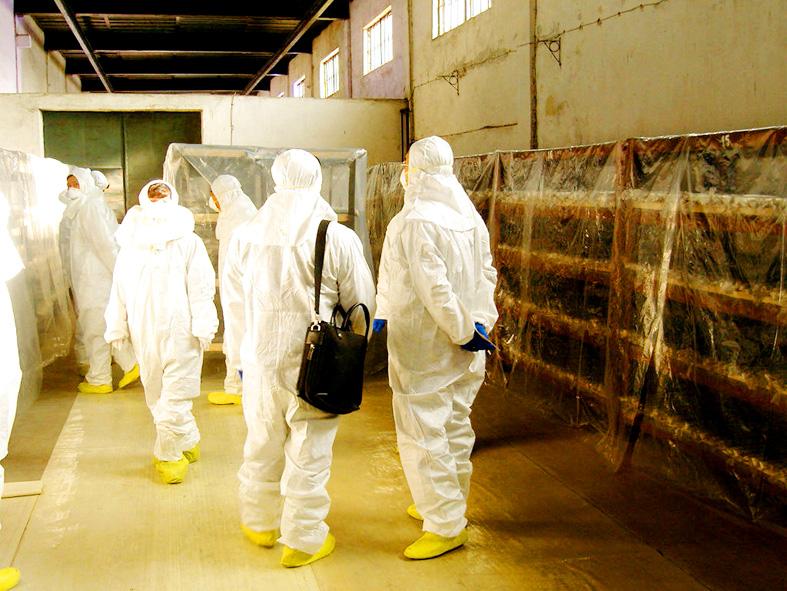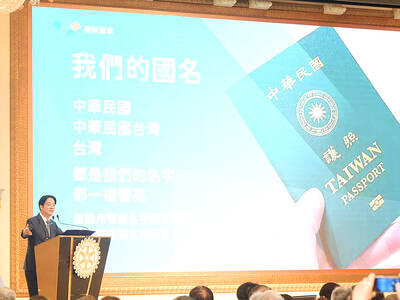North Korea appears to have restarted a nuclear reactor that is widely believed to have produced plutonium for nuclear weapons, the UN atomic watchdog said in an annual report, highlighting the isolated nation’s efforts to expand its arsenal.
The signs of operation at the 5 megawatt reactor, which is seen as capable of producing weapons-grade plutonium, were the first to be spotted since late 2018, the International Atomic Energy Agency (IAEA) said in the report.
“Since early July 2021, there have been indications, including the discharge of cooling water, consistent with the operation,” the IAEA report said of the reactor at Yongbyon, a nuclear complex at the heart of North Korea’s nuclear program.

Photo: AFP / South Korean Ministry of Foreign Affairs
The IAEA has had no access to North Korea since Pyongyang expelled its inspectors in 2009. The nation subsequently pressed ahead with its nuclear weapons program and soon resumed nuclear testing. Its last nuclear test was in 2017.
The IAEA now monitors North Korea from afar, largely through satellite imagery.
Commercial satellite imagery shows water discharge, supporting the conclusion that the reactor is running again, said Jenny Town, director of the US-based 38 North project, which monitors North Korea.
“No way to know why the reactor wasn’t operating previously — although work has been ongoing on the water reservoir over the past year to ensure sufficient water for the cooling systems,” Town said. “The timing seems a little strange to me, given the tendency for flooding in coming weeks or months that could affect reactor operations.”
Last year, 38 North said floods in August might have damaged pump houses linked to Yongbyon, highlighting how vulnerable the nuclear reactor’s cooling systems are to extreme weather events.
Seasonal rains brought floods in some areas this year, state media have said, but there have been no reports yet of threats to the site, the Yongbyon Nuclear Scientific Research Center.
At a 2019 summit in Vietnam with then-US president Donald Trump, North Korean leader Kim Jong-un offered to dismantle Yongbyon in exchange for relief from a range of international sanctions over nuclear weapons and ballistic missile programs.
At the time Trump said he rejected the deal because Yongbyon was only one part of North Korea’s nuclear program and was not enough of a concession to warrant loosening so many sanctions.
US President Joe Biden’s administration has said it reached out to North Korea to offer talks, but Pyongyang has said it has no interest in negotiating without a change in policy by the US.
“There has been no agreement governing these facilities for a long time now,” said Joshua Pollack, a researcher at the James Martin Center for Nonproliferation Studies.
It is a safe bet that North Korea intends to use any newly separated plutonium for weapons, Pollack said, adding that in a speech this year, Kim gave a long list of advanced weapons under development, including more nuclear weapons.
“North Korea’s appetite for warheads is not yet sated, it seems,” he said.

LONG FLIGHT: The jets would be flown by US pilots, with Taiwanese copilots in the two-seat F-16D variant to help familiarize them with the aircraft, the source said The US is expected to fly 10 Lockheed Martin F-16C/D Block 70/72 jets to Taiwan over the coming months to fulfill a long-awaited order of 66 aircraft, a defense official said yesterday. Word that the first batch of the jets would be delivered soon was welcome news to Taiwan, which has become concerned about delays in the delivery of US arms amid rising military tensions with China. Speaking on condition of anonymity, the official said the initial tranche of the nation’s F-16s are rolling off assembly lines in the US and would be flown under their own power to Taiwan by way

OBJECTS AT SEA: Satellites with synthetic-aperture radar could aid in the detection of small Chinese boats attempting to illegally enter Taiwan, the space agency head said Taiwan aims to send the nation’s first low Earth orbit (LEO) satellite into space in 2027, while the first Formosat-8 and Formosat-9 spacecraft are to be launched in October and 2028 respectively, the National Science and Technology Council said yesterday. The council laid out its space development plan in a report reviewed by members of the legislature’s Education and Culture Committee. Six LEO satellites would be produced in the initial phase, with the first one, the B5G-1A, scheduled to be launched in 2027, the council said in the report. Regarding the second satellite, the B5G-1B, the government plans to work with private contractors

‘OF COURSE A COUNTRY’: The president outlined that Taiwan has all the necessary features of a nation, including citizens, land, government and sovereignty President William Lai (賴清德) discussed the meaning of “nation” during a speech in New Taipei City last night, emphasizing that Taiwan is a country as he condemned China’s misinterpretation of UN Resolution 2758. The speech was the first in a series of 10 that Lai is scheduled to give across Taiwan. It is the responsibility of Taiwanese citizens to stand united to defend their national sovereignty, democracy, liberty, way of life and the future of the next generation, Lai said. This is the most important legacy the people of this era could pass on to future generations, he said. Lai went on to discuss

MISSION: The Indo-Pacific region is ‘the priority theater,’ where the task of deterrence extends across the entire region, including Taiwan, the US Pacific Fleet commander said The US Navy’s “mission of deterrence” in the Indo-Pacific theater applies to Taiwan, Pacific Fleet Commander Admiral Stephen Koehler told the South China Sea Conference on Tuesday. The conference, organized by the Center for Strategic and International Studies (CSIS), is an international platform for senior officials and experts from countries with security interests in the region. “The Pacific Fleet’s mission is to deter aggression across the Western Pacific, together with our allies and partners, and to prevail in combat if necessary, Koehler said in the event’s keynote speech. “That mission of deterrence applies regionwide — including the South China Sea and Taiwan,” he